Institute of Naval Medicine
The Institute of Naval Medicine is the main research centre and training facility of the Royal Navy Medical Service.
| Institute of Naval Medicine | |
|---|---|
INM | |
 Location within Hampshire | |
| General information | |
| Type | Military medical training facility |
| Address | Crescent Road, Gosport, Hampshire, PO12 2DL |
| Coordinates | 50.78°N 1.142°W / 50.78; -1.142 |
| Elevation | 10 m (33 ft) |
| Current tenants | Royal Navy Medical Service |
| Construction started | 1969 |
| Completed | 1969 |
| Inaugurated | 26 September 1969 |
| Client | MoD |
| Owner | Royal Navy |
| Technical details | |
| Floor count | 2 |
History
The site was established in 1969 to research environmental health conditions for submariners in the Royal Navy.
In November 1973 a £200,000 environmental medical centre opened, which simulated life inside a submarine.[1]
Research
Drowning
The site has done much research into drowning, which kills 700-1000 a year in the UK, with a third being males aged 15-35. Surgeon Commander Frank Golden, Director of Research in the 1980s did much important investigations. Many able swimmers died, no more than 10 yards from refuge, from effects of cold water.[2]
So-called 'dry drowning' is caused by the shock of cold water. A possible cause is cold water causing the larynx to spasm. Animals have a 'diving response', but humans hyperventilate, and the heart beats too quickly due to a chemical imbalance.[3]
Drowning is the third most common form of accidental death in the UK after road accidents and home injuries. It is often competent swimmers in canals, rivers or flooded quarries in spring or early summer, and there has not been much research on this form of drowning. Most deaths occur in the first three minutes, and those who last 15 minutes mostly last to 30 minutes. Admiral Frank Golden in the 1990s thought that the deaths were linked to the gasp reflex as found in cold showers. There is a big increase in blood pressure and heart rate. Uncontrolled rate breathing makes swimming impossible due to the cold shock response. Work had neen carried out with the University of Leeds on 'immersion hypothermia'.[4]
Diving
In the 1990s, Surgeon Commander James Francis found 'nitrogen narcosis' below 30m of water depth. [5] James Francis became Head of Undersea Medicine and left the Navy in 1996.
Women submariners
In 2010 the USA allowed women on its submarines but women submariners were not allowed in the UK as carbon dioxide in a submarine's atmosphere could damage a foetus. [6]
In December 2011 women were allowed on submarines, with officers first then all women from 2015. All women would serve on the Astute class submarines from 2016. Women had been on surface ships since 1990. There are around 3420 females in the Royal Navy, about 9%. [7]
Structure
It is situated in the south of Gosport. The Medical Officer-in-Charge is also the Dean of Naval Medicine.
See also
References
- Times Tuesday 6 November 1973, page 3
- 'Findings' Times Thursday June 7 1984, page 8
- Times 'Medical Briefing' Thursday 22 June 1989, page 13
- Times Thursday April 28 1994, page 17
- Times Tuesday 26 July 1994, page 13
- Times Monday April 26 2010, page 32
- Times Friday 9 December 2011, page 3
External links
| |||||||||||||||||||||||||||||||||||||
| |||||||||||||||||||||||||||||||||||||
| |||||||||||||||||||||||||||||||||||||
| |||||||||||||||||||||||||||||||||||||
| |||||||||||||||||||||||||||||||||||||
| |||||||||||||||||||||||||||||||||||||
| |||||||||||||||||||||||||||||||||||||
| |||||||||||||||||||||||||||||||||||||
| |||||||||||||||||||||||||||||||||||||
| |||||||||||||||||||||||||||||||||||||
| |||||||||||||||||||||||||||||||||||||
| |||||||||||||||||||||||||||||||||||||
| |||||||||||||||||||||||||||||||||||||
| |||||||||||||||||||||||||||||||||||||
| |||||||||||||||||||||||||||||||||||||